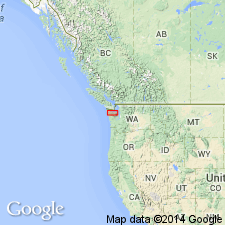
- Usage in publication:
-
- Hoko River Formation*
- Modifications:
-
- Named
- Reference
- Dominant lithology:
-
- Siltstone
- Sandstone
- AAPG geologic province:
-
- Olympic Mountains province
Summary:
[Named for Hoko River.] Type locality at exposures in stream bed and cliffs of Hoko River and in railway and road cuts parallel to river from point 1 km north of junction of Blue Canyon with Hoko River south to point 1.5 km north of Hoko Falls Bridge, northwest Olympic Peninsula, Clallam Co, WA. Two reference sections given. Is lower of three new formations in Twin River Group. Composed of fossiliferous siltstone with interbeds of phyllitic and basaltic sandstone, pebbly sandstone, and conglomerate. Described as thin-bedded to massive siltstone with conglomerate and sandstone channels and calcareous concretions. Conformably overlies, or intertongues with, Lyre Formation; gradationally, or locally unconformably, underlies Makah Formation (new) (Twin River Group). Is late Eocene (Narizian) age.
Source: GNU records (USGS DDS-6; Menlo GNULEX).
For more information, please contact Nancy Stamm, Geologic Names Committee Secretary.
Asterisk (*) indicates published by U.S. Geological Survey authors.
"No current usage" (†) implies that a name has been abandoned or has fallen into disuse. Former usage and, if known, replacement name given in parentheses ( ).
Slash (/) indicates name conflicts with nomenclatural guidelines (CSN, 1933; ACSN, 1961, 1970; NACSN, 1983, 2005, 2021). May be explained within brackets ([ ]).

